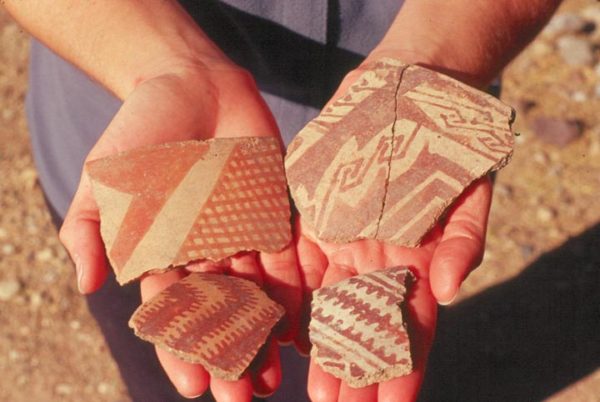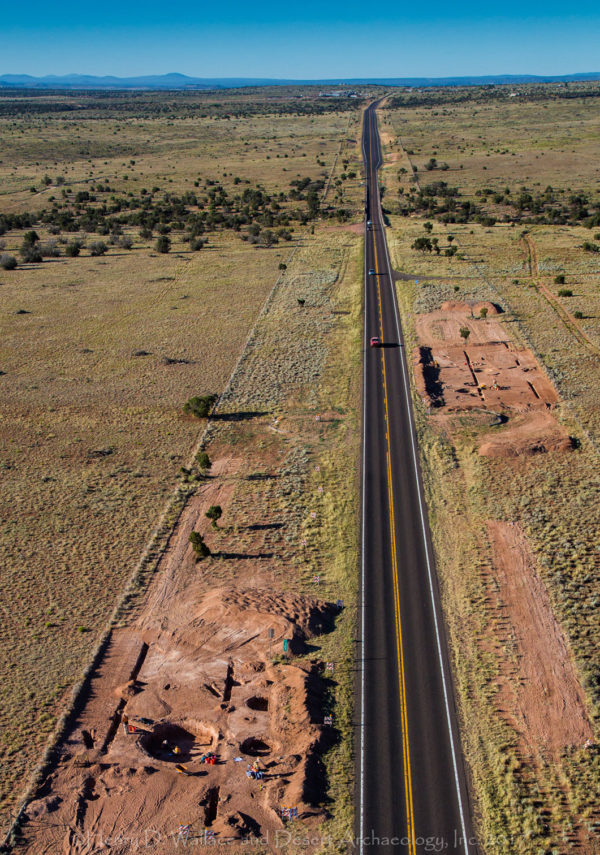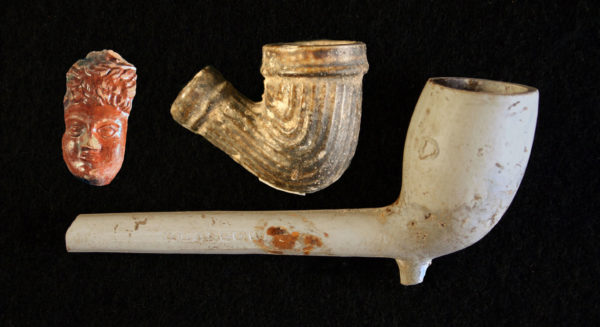
Prepared by our Past, Poised for the Future: Desert Archaeology Turns 40
On January 13, 1982—a Wednesday—Dr. William Doelle moved to Tucson and, days later, finalized a National Park Service contract for a project in Nolic. This marked the start of business for his brand new cultural resources management (CRM) archaeology firm, which set up shop as the Arizona Division of the California-based Institute of American Research. In 1989, the company left the IAR and became an independent entity, adopting the now-familiar name of Desert Archaeology, Inc. (DAI). We opened our second office in Tempe in 1999, and in January 2017, Dr. Sarah Herr became company owner and president.
In the 40 years following our humble beginnings in Bill Doelle’s garage, DAI has conducted over 2,700 archaeological projects throughout the greater American Southwest and produced research that has received local, state, national, and international acclaim.
Most of our work is compliance-based and includes record searches, surveys, testing, data recovery, mapping, museum exhibits, and creating text and images for interpretive signage. As land is developed, various historical preservation laws and ordinances require archaeological documentation. Desert Archaeology’s projects recover information in advance of development but also have the benefit of providing significant new understanding of the various peoples who have lived in the American Southwest over the last 10,000 years. The results of this work have been published in technical reports and academic journal articles, presented in public talks, and shown on interpretive signs in places ranging from streetcar stops to national monuments. To make this information even more accessible to the public, we post interesting findings on a variety of prehistoric and historical topics here on the Field Journal.
What are some of the things we have learned over the past 40 years?
Early Agricultural Period
The mid-1990s through today has seen extensive remodeling of the frontage roads along Interstate 10 through Tucson. Fieldwork has even taken place in the median and below the footprint of the existing road surface. Archaeological investigations directed by Andrea Freeman, Michael Diehl, David Gregory, Jonathan Mabry, Homer Thiel, James Vint, Gregory Whitney, and Helga Wöcherl resulted in the in-depth documentation of large Early Agricultural period villages, dating to roughly 1200 BC-AD 50, that were previously unknown or poorly understood. Excavations at the Santa Cruz Bend, Stone Pipe, Los Pozos, Wetlands, Clearwater, and Las Capas have revolutionized our understanding of this long period during which maize (corn) agriculture was introduced into southern Arizona. Burned pit structures have provided detailed data on how the people of this timespan constructed their dwellings and storage buildings. Large irrigation systems—the earliest yet encountered anywhere in North America north of Mexico—were documented at Las Capas. The introduction of the first pottery vessels and clay figurines in the region has been studied, along with changes in projectile point design and ritual practices.

Aerial view of an early field system documented at the site of Las Capas, Tucson, Arizona (photo by Henry Wallace).
Read more about our work on the Early Agricultural period:
This Old House Group: Residential Permanence During the Early Cienega Phase
The Early Agricultural Period Construction Boom
Early Agricultural Period Ceramic Figurines
Early Agricultural Period Mystery: Revisiting the Artifact Array at Los Pozos
Hohokam Sites
The Hohokam culture existed in the Sonoran Desert from about AD 500 to 1450. DAI projects led by Mark Elson, Kathy Henderson, Michael Lindeman, Deb Swartz, and Henry Wallace have documented village sites including Julian Wash, Honey Bee, Tanque Verde Wash, and Los Morteros in the Tucson Basin and La Villa, La Ciudad, and Park of Four Waters Canal in the Phoenix Basin. Our work has examined how communities evolved, explored how people traded goods between communities, looked at techniques people used to store foods and seeds, studied how people built and maintained canals, and improved chronologies by identifying how patterns on ceramic vessels changed through time. Despite decades of work at Hohokam sites, new things are being learned as new analytic techniques are developed.

Tanque Verde phase (A.D. 1150-1300) sherds from the Mission Garden locus of the Clearwater Site located near A-Mountain, with geometric, basket weave-like designs .
Read more about our Hohokam research:
Broad Perspectives from a Narrow Window: The La Villa Site
Baskets, Jars, Pits, and Platforms: Solving Storage Problems in the Ancient Southwest
The Hohokam of Fort Lowell: The Hardy Site
Northern Arizona Projects
While much of DAI’s work has been in the Tucson and Phoenix Basins, fieldwork has also been undertaken in central and northern Arizona. In 1987, Bill Doelle and Mark Elson went beyond the last saguaro to scout a project just south of Payson in central Arizona. The Rye Creek Project became the first out-of-Tucson project undertaken by DAI. The project was directed by Mark Elson and Debbie Swartz and included the excavation of 19 prehistoric sites along SR87 in the Upper Tonto Basin. A few years later DAI excavated 27 sites around Roosevelt Lake, also in central Arizona, prior to the raising of the Roosevelt dam. Mark Elson, Douglas Craig, Henry Wallace, and Deborah Swartz directed the excavations of two platform mounds sites, several multi-room stone compounds, pithouse villages, and a large pueblo site probably inhabited by migrants from northern Arizona. Research included the analysis of settlement patterns, subsistence, chronology, and social organization. Evidence for past migration into the Tonto Basin by Jeffery Clark was one of the key findings of this work. In the late 1990s, Mark Elson, Deborah Swartz, and Terry Samples led the excavation of 41 Cohonina and Sinagua sites along US Route 89, north of Flagstaff. Some of the sites had been affected by the eruption of Sunset Crater Volcano at about AD 1085. The eruption of Sunset Crater and its effects on the prehistoric inhabitants was one of the key research foci; the discovery of corn cob impressions in lava was likely indicative of ritual behavior by the Native Americans to possibly appease the supernatural forces causing the eruption. Sarah Herr worked with crews on State Route 260 in the Arizona Transition Zone. This rugged region and its small watered valleys were used by varied small groups of people with visible occupations from the Early Agricultural period on. By the mid seventeenth century AD, if not earlier, the area was occupied by Western Apache, whose landscape of resources included reusing and occupying earlier sites and harvesting and roasting wild plants. The creation of reservations and the Tonto National Forest removed them from full-time residence, but strong connections to these places remain for the people.

Basketmaker village excavated by Desert Archaeology, Inc. for ADOT in advance of improvements being made to the highway north of Snowflake, Arizona (by Henry Wallace).
Read more about our work in the north:
Mark Elson: Career Retrospective
How We Ask Questions: CRM Archaeology and the Land Between
Presidio San Agustín del Tucson and the San Agustín Mission
Tucson’s Spanish and Mexican past (AD 1690s-1856) has been explored by CRM archaeologists since the mid-1980s. DAI worked along with the Center for Desert Archaeology (today Archaeology Southwest) to locate the wall foundations of the Spanish- and Mexican-era fortress that stood in downtown Tucson. More extensive excavations allowed for the recreation of the northeast corner of the Presidio, which has been incorporated into the Presidio San Agustín del Tucson Museum. Work directed by Homer Thiel at the San Agustín Mission documented the surviving portions of this Spanish-era Catholic mission, located southwest of modern downtown Tucson near the Santa Cruz River. The walls of the Mission Garden were recreated, and today people can visit the site to see heritage orchards and crops that are now tended by the Friends of Tucson’s Birthplace. Archaeological and archival research has revealed much about the lives of the people who lived in Tucson, including what they ate, what the roles of soldiers and their wives were, trade with far distant places, and the importance of late-summer feasting.

Vessels created by local Native Americans, the O’odham and Pima peoples, were used for cooking soups and stews by Presidio residents (photo by Homer Thiel).
Read more about the Presidio and the San Agustín Mission:
Presidio San Agustín del Tucson Museum website
Friends of Tucson’s Birthplace website
Suppertime at the Presidio San Agustín del Tucson
The History of the San Agustín Festival in Tucson
Women in the Presidio San Agustín del Tucson
Zuni Pottery from the Presidio San Agustín del Tucson
Downtown City Blocks
Archaeological work preceding the redevelopment of downtown blocks in Tucson and Phoenix explored Territorial (1856-1912) and Statehood (beginning in 1912) period homes and businesses. We compiled the stories of once-forgotten residents of these communities using historical documents, documented archaeological features, preserved food remains, and artifacts. Some of these people include Hutchlon Ohnick, a Japanese entrepreneur who opened the Phoenix Illuminating Gas and Electric Works in 1886, Jack Boylen, Tucson’s first fire chief, and Soledad Jacome, a seamstress who raised four daughters as a single mother. Homer Thiel has spearheaded our investigations of metro Tucson’s past and has been instrumental in bringing the stories of these past residents to life in our reports as well as innumerable public talks.

Three ceramic pipes found in the backyard of the Siquerios-Jacome House. One has a molded face, a second originally had a wooden stem, and a third is the classic kaolin clay pipe (photograph by Robert Ciaccio).
Read more about the historic residents of your downtown:
Archaeology Archive: The 1996 Excavations at Historic Blocks 72 and 73, Phoenix, Arizona
The Archaeology of Scandal: Artifacts, Documents, and the Secrets of Tucson’s First Fire Chief
Soledad Jacome: Historical Archaeology and a Rediscovered Life
Petrography and Ceramic Studies
The Desert Archaeology petrography program was developed by petrographer Elizabeth Miksa and senior ceramic analyst James Heidke. DAI petrographers have collected hundreds of sand samples from throughout Arizona, counted the minerals and rock fragments, and used these to identify the source of the raw materials in ceramic sherds. These analyses have allowed Heidke, Miksa, and Miksa’s successor, Mary Ownby, to identify where ceramic vessels were made and to study the movement of vessels between communities and how this changed through time.

Desert Archaeology is unique in having collected and analyzed almost 1,500 sand samples throughout Arizona. This has allowed us to identify many petrofacies in 11 different regions. For these areas, we can reconstruct social and economic networks based on the movement of ceramics.
Read more about petrography and ceramic characterization analysis:
The Beginning of Hohokam Sand Temper Provenance Studies
Mobility and Pottery Production
Hohokam Ceramic Studies: Past, Present, Future
Diet and Environmental Studies
What did people eat, in both the recent and distant past? What was the environment like around their homes? How did this change through time? DAI analysts Michael Diehl and Jenny Waters have analyzed thousands of plant remains and animal bones to answer these questions. Diehl’s research begins after our lab techs process flotation and pollen soil samples to recover plant remains. He identifies them using a microscope and uses the collected data to learn how people organized their lives around foraging wild plants, managing tree resources, and harvesting crops. Waters compares recovered faunal bones to comparative collections. The changing percentages of jackrabbits and cottontails can provide clues about the environment around ancient sites. Animal bone identification is equally important for historical archaeology; Waters has compared the types of meat consumed by residents of the Presidio San Agustín del Tucson to rations recorded in surviving documents, and has explored the differences in diets between people of differing ethnicity and socio-economic status in nineteenth-century Tucson.
Read more about diet and environmental studies:
What’s in that Bag of Dirt? Flotation Samples and Archaeology
Rabbit, Rabbit: The Small, Furry, and Fast Dietary Staple of Ancient Arizona
Meat: What’s for Breakfast, Lunch, and Supper!
Stones, Flaked and Ground
DAI staff members have written the standard reference books on the analysis of ground stone artifacts and Early Agricultural projectile points. Jenny Adams (and now her successor, Tessa Branyan-Martin) examine ground stone artifacts under a high-power microscope to determine how these items were used and how their use changed through time. R. J. Sliva’s studies of flaked stone artifacts, with important contributions by Stacy Ryan, have touched on the changes in lithic technological traditions and projectile point designs, exchange, social relationships between people in the Tucson Basin, and long-distance population movements.

Outstanding examples of projectile points from southern Arizona. The leftmost four are from the Early Agricultural period (2100 BC-AD 50) in the Tucson Basin; the rightmost two are Sedentary period Hohokam (A.D.950-1150), from the La Villa site in Phoenix and the Gatlin site near Gila Bend (photo by RJ Sliva).
Read more about stone artifact analysis:
We Wrote the Book on That: Featured Works by Desert Archaeology Authors
The Tell-tale Art: Recognizing Use-wear on Stone Tools
It Takes Both: Identifying Mano and Metate Types
Historic Native American Arrow Points in Southern Arizona
Hohokam Flake Tools and the Eye of the Beholder
Jewelry
The Early Agricultural, Early Ceramic, and Hohokam people of the Sonoran Desert liked to adorn themselves with shell, stone, and fired clay jewelry. Most of the shell that Christine Virden-Lange has identified in Tucson Basin assemblages comes from either the Pacific Ocean (off the coast of southern California) or the Gulf of California. In both cases, people traded either shells or completed shell jewelry across hundreds of miles of desert. Paths worn in desert pavements suggest that some people living in the Tucson Basin may have walked all the way to the ocean, perhaps collecting salt as well as shells. Shell jewelry continued to be used into the Spanish period in Tucson.
Tiny disk beads made from stone, shell, and clay have been found in Arizona. Dr. Jenny Adams and Allen Denoyer explored how these were made by replicating them. Elaborate and beautiful cruciforms, found at Early Agricultural period sites, were often deliberately broken, perhaps in some sort of powerful ritual.
Read more about jewelry:
From the Pacific Coast to the Tucson Desert: Cienega Phase Shell Artifacts at the Clearwater Site
Early Agricultural Period Shell Ornaments in the Tucson Basin
Black, Red, and Green: Abalone Shell Trade in the Ancient Southwest
The Broken and the Whole: Cruciforms in the Tucson Basin
Archaeological Conundrum: The Tiny Disk Bead
Public Outreach
Many Desert Archaeology projects have been funded by taxpayer dollars, so it has been important for us to share the results of fieldwork with the public. On some projects, community volunteers and student interns have worked alongside DAI employees, allowing for an up-close experience of archaeology. Public tours have also been popular. Thousands of people visited our work at the Presidio San Agustín and San Agustín Mission, led through the sites by Patti Bell and Irma Moreno. Robert Ciaccio, Catherine Gilman, and Emilee Mead have created interpretive signs for Julian Wash Archaeological Park, Paseo de Las Iglesias trail, the Loop, and Vista del Rio Cultural Resource Park in Tucson, Steam Pump Ranch in Oro Valley, and the Los Morteros Heritage Trail in Marana, as well as Casa Grande National Park, Tonto National Monument, and the Kaibab National Forest to the north of us in Arizona.
DAI has curated several exhibits at the Arizona Historical Society and has installed a permanent exhibit at the Evo A. DeConcini United States Courthouse in Tucson. Public lectures by DAI staff are well attended—some are available online—describing our work at Early Agricultural, Hohokam, and Spanish period sites. DAI researchers have also been frequent contributors to the thematic Archaeology Southwest magazines https://www.archaeologysouthwest.org/product-category/archaeology-southwest-magazine/.
Read (and watch!) more about our public outreach:
Desert Archaeology Public Outreach: Bringing the Past to the Present
Archaeological Illustration with Rob Ciaccio: Bringing the Past to Life
Homer Thiel Lecture: “Recent Archaeological Finds in Downtown Tucson” presented 6/27/20
Henry Wallace Lecture: “Hohokam Cults and Sodalities: A New Perspective on the Hohokam”
Jim Vint Lecture: “Early Agriculture in the Tucson Basin”
Our Team through Time
Desert Archaeology could not have accomplished four decades of archaeology without the talents of hundreds of people, including a wide range of archaeologists, data experts, geologists, editors, managers, graphic artists, surveyors, and more. Below are the names of current and former employees who have worked for the company for more than a year. Visit our staff page for more about our people, their specialties, and their after-hours interests.






